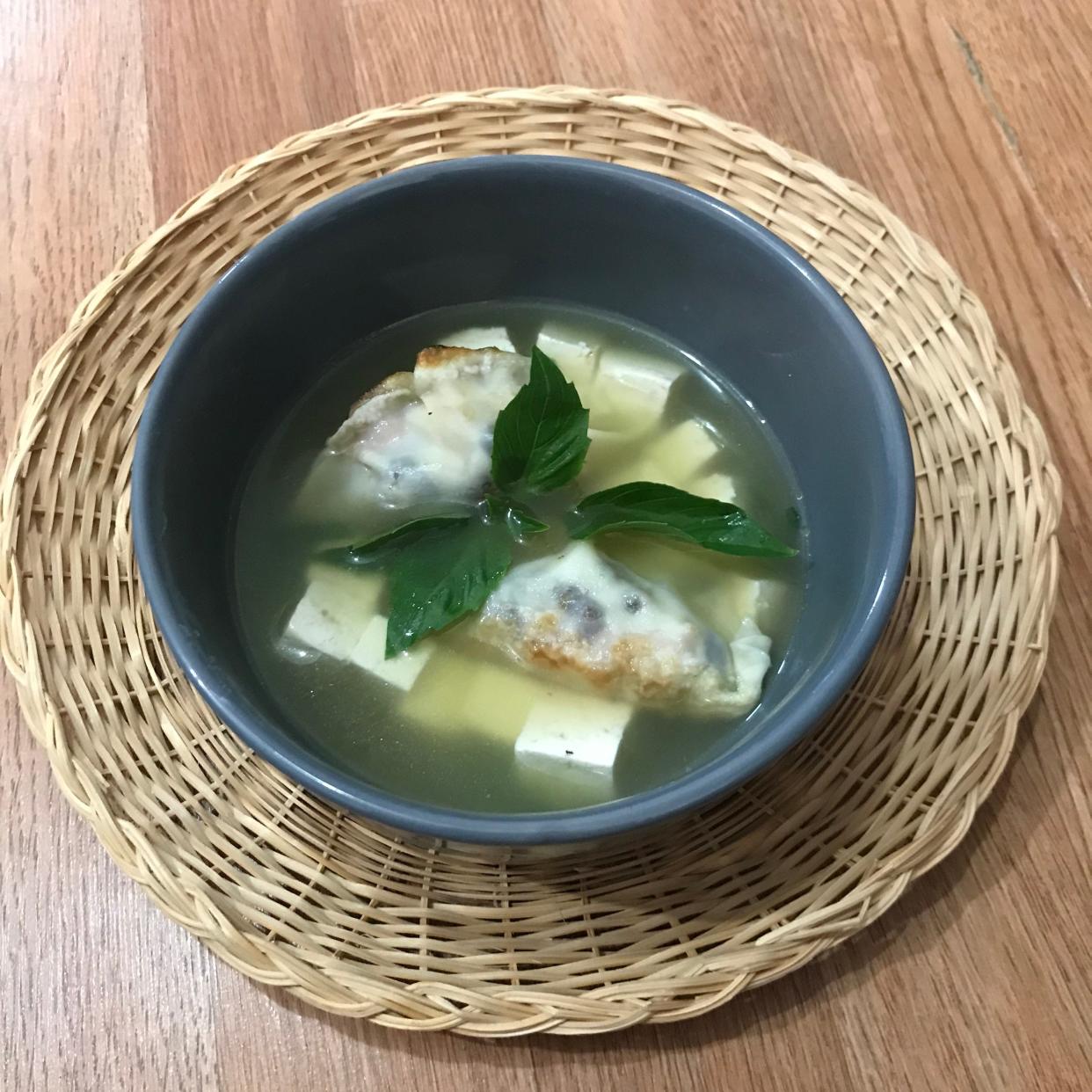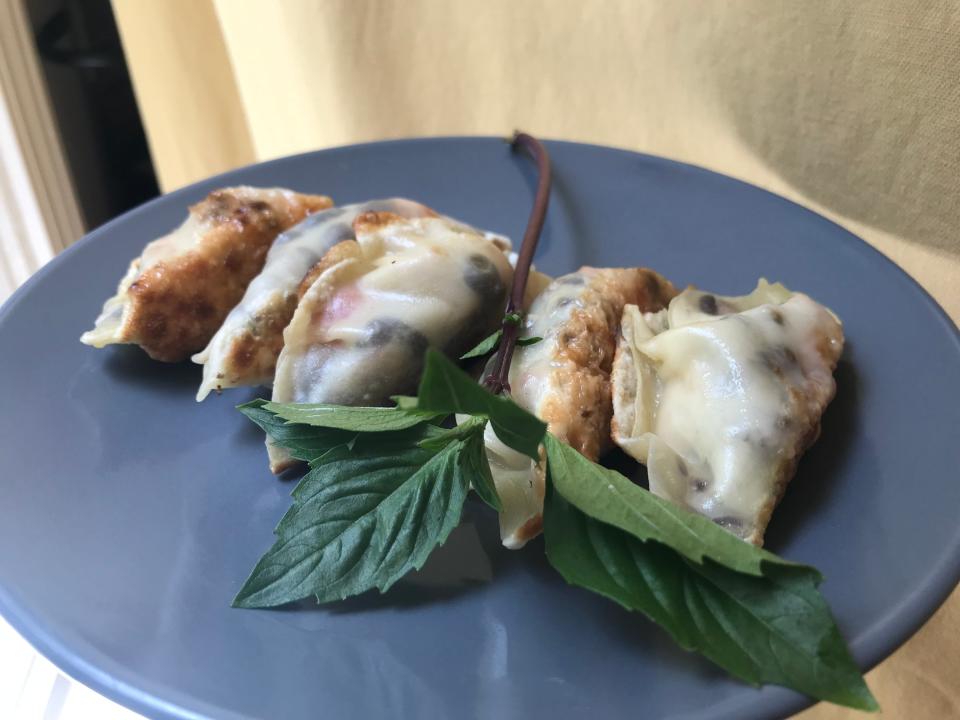Food Fare: Find comfort (food) with soup and floating dumplings

During a recent week in Washington, D.C., I (Frank) was with my children all day, every day while Kirstin attended an event. We had a good time, especially considering that my idea of fun tourism entailed our 5- and 8-year-old walking around the city for upwards of six miles a day.
Some of the museums weren’t quite what I hoped for — the plethora of LCD screens can feel overwhelming for members of my household — but the Smithsonian National Museum of Natural History museum was a delight, full of dinosaur bones and gemstones.
Of course, visiting these treasures left our youngest feeling especially exhausted, since her brain worked overtime to process all the amazing things she’d seen. By that evening, she was so floppy that I resorted to peanut butter and jelly sandwiches for dinner. She ate hers with her eyes closed.
And she wasn’t the only member of our family who felt tired. I like to imagine that I’m a tolerably good parent, but that much caretaking with few breaks left me weary.
So I was grateful when we returned to Bloomington and my kids attended a week of daycamp at the YMCA run by Chelcey Bostic and her team of intrepid young counselors, who’ve kept hundreds of children healthy and happy at mid-pandemic camps.
I dropped my children off for their first day, hugged each, and found myself thinking of “Mouth Almighty,” a species of Australian fish.
Mouth Almighty is a “mouth brooding” fish — males will scoop up fertilized eggs and keep them safe until they hatch. And a research team recently discovered that some males will protect hatchlings to whom they have no genetic relationship.
We don’t know yet why they do this: whether it’s a mistake; or if they’re trying to display caretaking prowess in order to seem more attractive to potential future mates; or if they simply find pleasure in helping to raise young.

But no matter the reason, I love learning about moments of apparent kindness and collaboration in the natural world.
Similarly, I spent a delightful week re-reading my favorite YA fantasy novels about young people attending a wizard school: Naomi Novik’s “Deadly Education” series. In these books, there’s high-stakes competition among the students because the school itself is out to harm them. But Novik also speculates about what would happen if people in that environment set aside their reflexive competitiveness and worked together. At times, only cooperation can save us.
For this week’s recipes, we’re sharing a food that’s best made as a team. Dumplings, spring rolls, spanakopita — by yourself, I suppose you could prepare enough of these to feed a gathering, but it’s much more fun to have guests sit down and fold them together. Instead of one person feeling beleaguered, alone in the kitchen, the prep work can become another chance to talk and laugh.
And if you’re feeding children? Well, in our household, my kids are always much more eager to eat foods they’ve prepared themselves. This is a trick we learned from their preschool teachers — Robyn Miller, Christie Cooper and Mary Beth O’Brien — who taught a whole roomful of students to cook soup. Soon, they were all gleefully eating vegetables that many had previously refused to touch at home. Because deep down, don’t we all want to feel like we’ve helped?

Jackfruit Dumplings
There are many different sets of vegetables that would work to make a reasonable filling for these, but I always aim to pair jackfruit with hearty pulses like the black beans used here. Jackfruit makes a reasonable meat substitute in terms of texture, and it’s mild enough that with the right spices you can make it taste fantastic, but it has very little protein. Attempting to use only jackfruit as the filling for a sandwich or dumpling would remind me of the vegetarian meals that consist solely of bread and salad. Yes, you could make it fancy, but it wouldn’t be the right balance of nutrition. (At Kirstin’s award event in D.C., she was served an extremely low protein meal by a very expensive caterer.) Most big grocery stores now carry gyoza dumpling wrappers in the freezer section, but you can also buy them at many international markets. The amount of filling we’re listing here will make, we think, about 50 dumplings. You can eat the seasoned vegetable mix as a side over rice or noodles if that number of dumplings seems excessive.
10 ounces canned green jackfruit, drained and rinsed
15 ounces canned black beans, drained and rinsed
6 ounces sweet bell peppers, chopped
6 ounces cherry tomatoes, chopped
1.5 tablespoons olive oil
½ teaspoon ground cumin
½ teaspoon table salt
¼ teaspoon black pepper
¼ teaspoon garlic powder
1 package (about 100 count) frozen gyoza wrappers, thawed
Add the jackfruit and oil to a nonstick pan and heat on medium for approximately 10-15 minutes. As it heats, use a spatula to coarsely chop the jackfruit so that it begins to separate into thin strands. Then add the spices and black beans, stir well, and continue to saute for 5 minutes, stirring every minute. Add the peppers and tomatoes and saute for a final 2 minutes, then remove from heat.
To make the dumplings, add approximately 1 heaping tablespoon of the cooked mixture to the center of a wrapper, dip your fingertips in water and trace around the wrapper’s perimeter to wet the edges, then pinch closed in a bulbous semicircle. I am sufficiently patient to make perhaps five of these on my own, but hopefully this is the portion that your gathered family or friends are willing to help with. Another great benefit of having helpers is that you can tell yourself that it was someone else’s dumpling that had structural problems if any fall apart when you fry them in the next step.
Once the dumplings are folded and ready (and hopefully spaced enough on a waiting plate or tray that they don’t all stick together), add cooking oil to a pan (about 1 teaspoon for a small pan, up to 1 tablespoon for a large pan), heat on medium until warm, then cook the dumplings. We typically put them into the pan with the folded edge up at first, heat for one minute, then toast for an additional minute on each side. If you’re serving these with soup, you’re done! If you’re serving these on their own with a dipping sauce, toss approximately ½ cup water into the pan and cover, steaming lightly for approximately two minutes.
Simple Soup (for Floating Dumpings)
Per person, you’ll need:
2 cups water
4 ounces tofu, in small cubes (we like firm here)
½ tablespoon chopped fresh ginger
1 tablespoon miso paste
1 teaspoon nutritional yeast
½ tablespoon basil, rolled and chopped
Soy sauce for drizzling
Sesame oil for drizzling
Combine the water, tofu, ginger and nutritional yeast, simmer for 10 minutes. Remove from heat and stir in the miso paste and basil.
If you’ve lightly steamed your dumplings after frying them, you might serve them with a dipping sauce made from two parts soy sauce to one part lime or lemon juice, but during a heat wave, I think they’re best paired with soup — I imagine most of us are feeling pretty dehydrated by the end of the day right now. Also, a bowl of miso soup is a nice way to replenish your electrolytes without resorting to Gatorade.
To serve, float 3-5 dumplings atop the bowl of soup, drizzle with soy sauce and sesame oil, and perhaps garnish with a sprig of basil, depending on how fancy you’re trying to be.
This article originally appeared on The Herald-Times: Find comfort (food) with soup and floating dumplings

